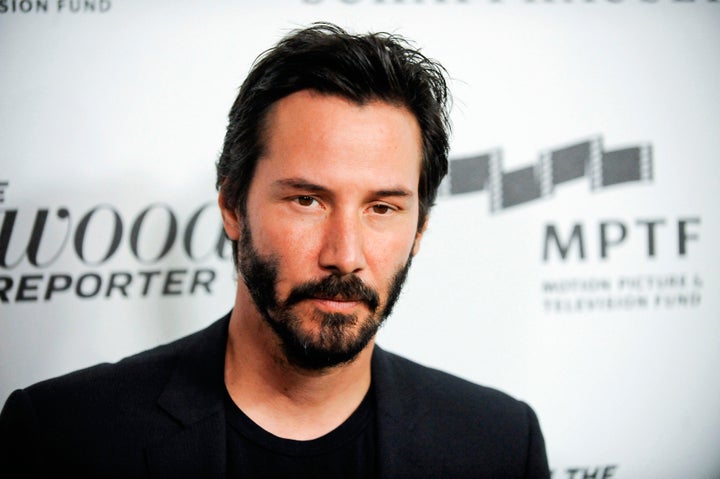
I have always wondered why Keanu Reeves is “white” and Tiger Woods is “black,” because both are Asian. The actor and athlete, who each have achieved that rare prominence of being referred to by first name alone as if any stranger in fact was acquainted with them, demonstrate how we assign people to categories based on images that overpower reality.
Together, they present the choices that seem available to Asian Americans: to be white or to be black. The alternative is to be a perpetual foreigner.
Reeves was born in Beirut when it was a resort destination. His biological father was predominantly Hawaiian Chinese; his mother, English. The leading man reportedly is estranged from his father, having been raised by his mother in Canada. His given name is inspired by a Hawaiian term for wind over the mountains.
As one of his characters might proclaim, “Whoa.”
He is not only white, he is archetypal. His big break came in the Bill and Ted adventure films. He was a stoner, with a blank look that enabled the audience to project onto him whatever interior life the respective viewer preferred he have. He was a Valley Guy, a representative of a place, suburban Southern California, as well as an era, the 1980s, and a generation, for whom his demeanor is ideal.
In later flicks, such as Speed and The Matrix, he remained a prototype. If anything, ironically he was inscrutable (as Asians are reputed to be). Surface was substance.
In Point Break, a Zen surfing heist thriller with a deserved cult following, he portrayed a former football star turned law enforcement officer, called “Johnny Utah,” a moniker that signifies arch-assimilation (maybe it could be outdone by “Johnny Kansas”). In Street Kings, a first-class “B” movie, he is a conflicted cop who in the opening scenes busts Asian criminals, replete with ethnic epithets.
Woods was cast as a reluctant spokesperson for the mixed race movement. Transforming golf literally single-handedly as when he bounced a ball off his club repeatedly and nonchalantly, he joined Oprah Winfrey to discuss his parents: a father who was a black American Army Green Beret, who boasted white and Native ancestry; a mother who was Thai albeit similarly diverse. Woods called himself “Cablinasian,” a portmanteau term he invented for himself. His given name of “Tiger” honored a Vietnamese soldier who had saved his father’s life.
His greatness set off a surreal dispute among Asians and African Americans. They each wished to own him, as if they were picking teams. Blacks approved of Woods, with his father, recalling the segregated courses of his youth, respecting his forebears in the sport, subtly calling out racial discrimination that had prevented them from receiving due awards. They lamented the tendency of some upwardly mobile African Americans to disassociate themselves from the community from whence they had come. Asians asserted that mathematically he was Asian to a greater degree than anything else, he believed in Buddhism, and he had spoken about feeling Asian.
The matter was resolved when an older competitor made clear that Woods, for all the talk of being mixed and the Thai maternal line, was indelibly, not positively, black. Fuzzy Zoeller, asked for his opinion of the young phenom, made a casual remark. The winner of the Masters tournament is allowed, in one of those rituals of the game, to select the menu for the group dinner of the players. As the field was being vanquished by Woods, Zoeller told a camera crew trailing behind him that they should tell the boy not to serve fried chicken and collard greens “or whatever the hell it is they serve.” (It would have been equally inapt if he had said, “curry chicken and lemongrass soup,” but the actual quip was a dismissive stereotype of “black” food.)
The general response to these examples is, “Yes, of course, because that is how those individuals look.” What is interesting about this reaction is that it reveals our perceptions of race are about appearance. They are not affected by data.
A person who is told that Reeves or Woods is part Asian might say, “Oh, yes, around the eyes,” but their general impression is not altered. We are beholden to what we see. There is hardly ambiguity.

Even that most quintessential Asian, Bruce Lee, was in that quaint phrase, “Eurasian.” His public persona was exotic. Yet his actual heritage was common enough where he grew up.
When the terms “Oriental” and the less polite “Chinaman” were still in common use, Lee achieved fame that was unprecedented and global. Despite having been passed over for the Kung Fu television series, a role that went to a Caucasian who was accomplished as a dancer, the martial arts expert went on to star in his own stories on the big screen, establishing himself as masculine, powerful, and virile.
He also was at least one-quarter European in lineage. He was a member of a prominent house in Hong Kong. His genealogy led to controversy within the then-closed society of Eastern fighting schools. He insisted, to the further indignation of his peers, on training people of all origins, boasting a star student who was African American. As a consequence, he was challenged to prove his right to continue practicing his trade. The battle with Wong Jack Man in Oakland has become myth.
His death at an early age of a brain hemorrhage, as he was developing what would have been the first big-budget Hollywood martial arts picture, was attributed by conspiracy theorists to a curse for sharing kung fu secrets with outsiders. He has become all the more a legend since then. His appeal is universal.
His counsel was, “Be like water, my friend.”
All but forgotten is that he was a native-born American, coming into the world in that most Chinese of cities, San Francisco, California. Thanks to the Supreme Court case affirming birthright citizenship, brought by one Wong Kim Ark of the same hometown, son of immigrants who could not naturalize due to a racial bar, Lee, like others who can claim roots on this soil, was legally an equal.
Asian Americans have sought to appropriate the term “hapa” to cover these persons. A Hawaiian word, it originally was derogatory. It has been taken over as celebratory.
There are many examples, beyond Asians and Asian Americans, of public race and private identity being mismatched. The phenomenon harkens back to the “one drop” rule reflecting a philosophy that any “black” blood taints the purity of whiteness. “Passing” has been practiced likely from the first encounter of populations with differing statuses correlated to color.
Salma Hayek, for example, is internationally admired as a Mexican movie star. She is as Mexican as could be. Yet she has become an American citizen. In terms of ancestry, she is only half what she is regarded as; her father is Lebanese.
For that matter, Frida Kahlo, whom Hayek portrayed in a hit biopic, is revered as a Mexican painter and feminist heroine. Yet Kahlo was like Hayek. her father was German, and, in the narrative Kahlo herself promoted, Jewish — though later investigation has suggested he was German but not Jewish.
The point is that racial categories are social constructs. They correlate only approximately to their supposed biological basis.
And racial blending is neither new nor rare. The possibility is what makes us all human.
